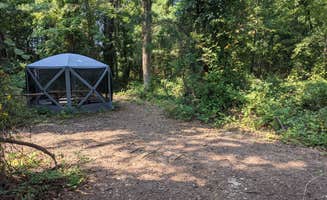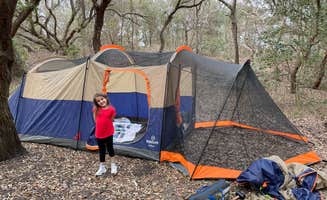Tent camping near Fort Monroe, Virginia offers access to both coastal ecosystems and inland forests within a relatively short driving distance. The region sits at the mouth of the Chesapeake Bay where campers experience humid summers with temperatures frequently reaching the high 80s. Winter camping remains viable with average lows rarely dropping below freezing, though coastal winds can create challenging conditions for tent setup.
What to do
Kayaking waterways: Sandy Bottom Nature Park provides calm lake waters perfect for paddlers. One visitor mentioned, "To kayak here it's the bomb!" while others noted the availability of boat rentals for those without their own equipment.
Wildlife viewing: Merchants Millpond State Park Campground offers unique swamp ecosystem exploration about 90 minutes from Fort Monroe. A camper described the experience: "The cypress trees, swamp flora and fauna are amazing. One of my kids caught a gar, we saw a bald eagle's nest, snakes, frogs, turtles, and lily pads everywhere."
Beach exploration: False Cape State Park Campground provides less crowded coastal exploration compared to Virginia Beach. A visitor explained, "Really there wasn't hardly anyone else out there, so it felt like we had our own private beach... Plus there are a ton of different types of birds out there if you like wildlife."
Hiking trail networks: Multiple trail systems connect throughout the region's parks. At Sandy Bottom Nature Park, a reviewer noted, "There are miles of trails around the lake and through the woods you can follow. It is extremely dog friendly with a fenced in dog park as well."
What campers like
Private beach access: Waterfront camping provides exceptional sunrise views. According to one False Cape visitor, "Such an amazing experience to wake up to the sun rising over the Atlantic ocean and sleeping under the stars. There were only two other tents camped out on the beach with us when we were there so it was still pretty isolated."
Well-spaced sites: Sandy Bottom Nature Park offers good separation between camping areas. A recent visitor observed their tent sites "were located about 1/4 mile from the parking lot down a trail. They were spaced nicely apart and had nice sand tent platforms with a picnic table and a fire ring with a grate."
Natural shade coverage: Many campgrounds feature tree coverage for heat protection. At Wisteria Beach Hideaway, a camper mentioned, "The provided insect screen kept us well protected in mid-sept. The hosts had extra supplies tucked under the table which is always a nice touch."
Clean facilities: Despite being primitive, several campgrounds maintain good sanitation. According to a Bennett's Creek camper at Merchants Millpond, "My group and I stayed at the Benett's creek high ground primitive camp sites 1-3. It was a 4.5 mile paddle to the site, then roughly 1.5 down to the dock with a staged vehicle."
What you should know
Bug preparation essential: Insects can be intense, especially in summer months. A False Cape camper advised, "We came in mid-June and the weather was gorgeous - 80s during the day and 60s at night. There were some biting flies and mosquitos but nothing a little bug spray couldn't take care of."
Water access challenges: Some sites require significant planning for water supplies. At Merchants Millpond Backpack Campground, a visitor explained their challenge: "Unfortunately we didn't stay because our site was hike in and I thought I did drive in. So we ended up getting a hotel instead."
Road noise considerations: Some campgrounds, despite natural settings, experience highway noise. A Sandy Bottom Nature Park visitor noted, "The biggest negative was that no matter where you were in the park, there was significant noise from the highway. Horns honking, sirens blaring, the general rush of cars going by."
Advanced reservations needed: Popular weekends fill quickly at accessible sites. For Wisteria Beach Hideaway, a camper commented, "Terrific campsite we found on HipCamp. Super close to a few different beaches. The bug screen and hammock that are part of the site was so appreciated."
Tips for camping with families
Child-friendly beaches: Some beaches provide safer swimming conditions for children. At Wisteria Beach Hideaway, a visitor noted, "Loved the location - the beaches were surrounded by pine, wetlands, and tall grasses - it felt remote and not overdeveloped!"
Trail difficulty consideration: Assess hiking distances for younger children. One False Cape visitor shared their experience with children: "We brought our 2 and 4 year old children. My husband and I each hooked a trailer to our bikes, and I towed the kids and he towed our gear. The kids loved riding through Back Bay."
Animal encounters: Wildlife viewings offer educational opportunities. A Merchants Millpond visitor shared, "This park was great but do recognize that is a true swamp. Alligators included. The water there does not move therefore is not recommended for filtering for consumption."
Equipment transportation: Plan for gear hauling with children in tow. A False Cape State Park camper advised, "We're both in good shape, and on bike we made the trek in less than an hour. I rode my mountain bike, and my wife road her hybrid commuter bike without issue. We brought a collapsible 5 gallon jug that I had to ride back to the visitors center."
Tips from RVers
Limited RV accommodations: True RV sites near Fort Monroe are sparse. A Carter's Cove Campground visitor noted the site is "More of a long term stay but there are a few spots for RV's Laundry, trash, restrooms, picnic table, fire pit (day use only). Mature trees and over all space is very large. Sites are level with some spacing."
Access road limitations: Many campgrounds have restricted vehicle access. A Sandy Bottom Nature Park visitor explained, "This campsite and park is a ton of fun. We've never camped here but we lived about 5 minutes down the road from the park and absolutely loved it."
Electric options: When available, hookups are often limited to 30-amp service. Tent camping near Fort Monroe generally provides more options than RV camping, with most sites focusing on primitive or walk-in accommodations rather than developed RV facilities.





